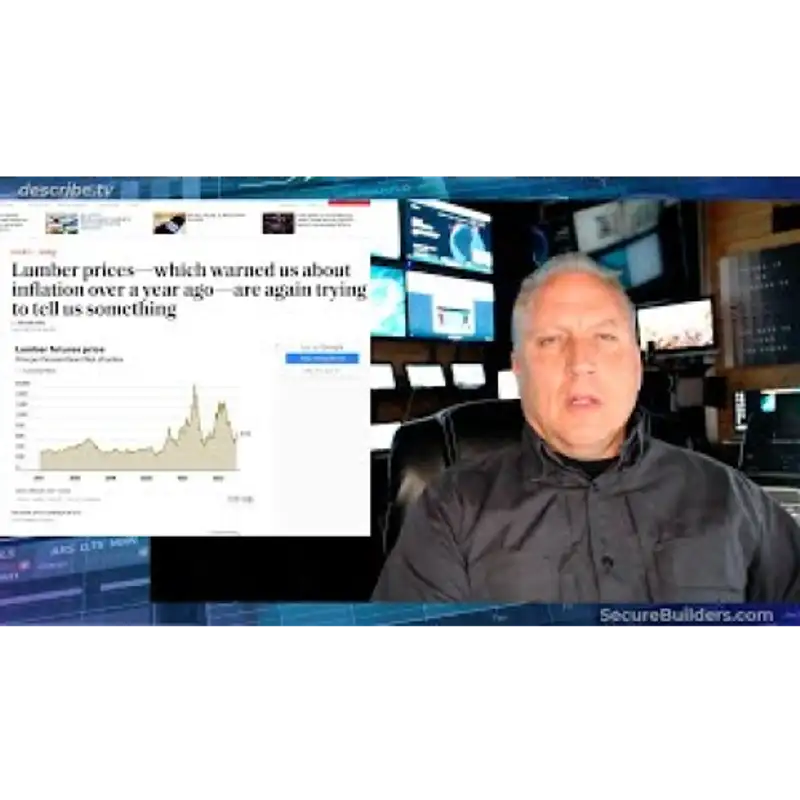Timber Trends: Decoding the Message Behind Rising Lumber Prices
Download MP3Look, we're all trying to have a crystal ball on what's happening with lumber prices because it affects all of us—whether we're a builder, contractor, homeowner, lender, or even in the lumber industry. Where the prices are going is going to affect our future and what plans we make.
So, here's a recent article from Fortune saying that lumber prices, warned about inflation, are trying to tell us something. What is it trying to tell us? And here's the very volatile chart of lumber prices, showing where they've been.
For many decades, they always stayed in the roughly three to four hundred range. Now, they've been up over a thousand, back under a thousand. What are they saying? Well, buried in this article is a very interesting fact. Let's take a look.
Here it is, right here: The way lumber prices behave in the fall—when commodity prices traditionally rise—could be a big signal in how bad the economic contraction will be. That's the question. It will be interesting to see if lumber starts to move back up. It would tell us that the U.S. economy is starting to sift through the interest rate hikes and inflation and that the economy may not be as bad as people think it will be.
That's the key. We're already starting to see people get used to the higher interest rates, especially in real estate. The real estate sales volume, although lower, hasn't caused prices to drop significantly. There have already been some job numbers released—300,000-some new jobs formed.
There's certainly an emotional reaction to inflation, lumber prices, interest rates, and gasoline prices that happened in May, early June, and mid-June. People pulled back, took a breath. The question is, what happens after the summer? Once people get over their vacations, out of quarantine, and past the distractions of recent years, they will decide: Are we going to buy a new house? Add on to our house? Spend more money? Or is the economy going to collapse further?
The economy zipped up, then leveled off a little. Now, the question is: Does it dive, or does it continue to climb? Regardless, it’s certainly not going to climb at the same rate it did before. But the fact that there’s inflation and that employment numbers are still looking good could indicate that the next move might be slightly higher. If real estate moves higher, then lumber prices will follow suit.
Think about it—there’s been a pullback on the retail side because people are staring at $6 gas, 6% mortgage rates, higher food bills, and so they pulled back. The lumber industry did the same emotional pullback. The question is: Once the fundamentals kick in, what’s going to happen?
So, here we are, in the middle of July. Let’s all keep an eye on it, and maybe in September or October, we can circle back, compare lumber prices then to now, and analyze the overall economy. Lumber prices can be a leading indicator in some cases, but when emotions drive the market, they can also be a lagging indicator. People might get scared and not buy lumber futures.
A lot of builders who build more in the summer and fall have already bought their lumber. Some parts of the country don’t do much lumber framing construction in the cold winter months. In some areas, building simply isn’t possible in winter. When that pullback naturally happens, we’ll see how far back it goes. If it stays the same or creeps up a little more, that means we’re probably in line and preparing for a higher move up.
It’s kind of like the groundhog—if he sees his shadow, he runs back, and we get six more months of winter. If we see a pullback in the fall, that probably means there’s more downside ahead. On the other hand, if the lumber price "groundhog" doesn’t see a downward move in the fall, it means consumers are at least holding strong for now. That could mean higher lumber prices in the future or at least a new normal range of $600 to $700 for years to come.

